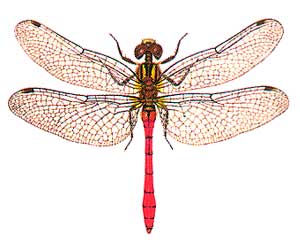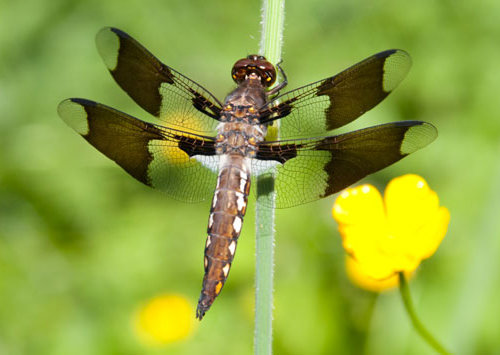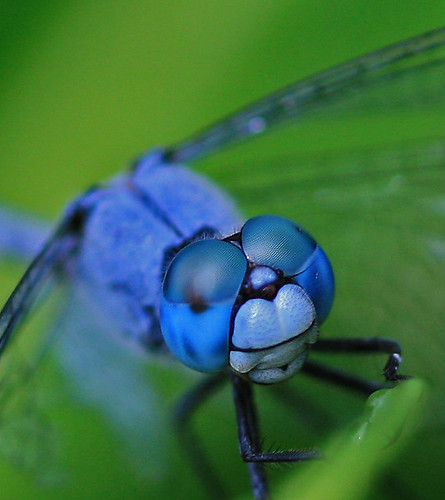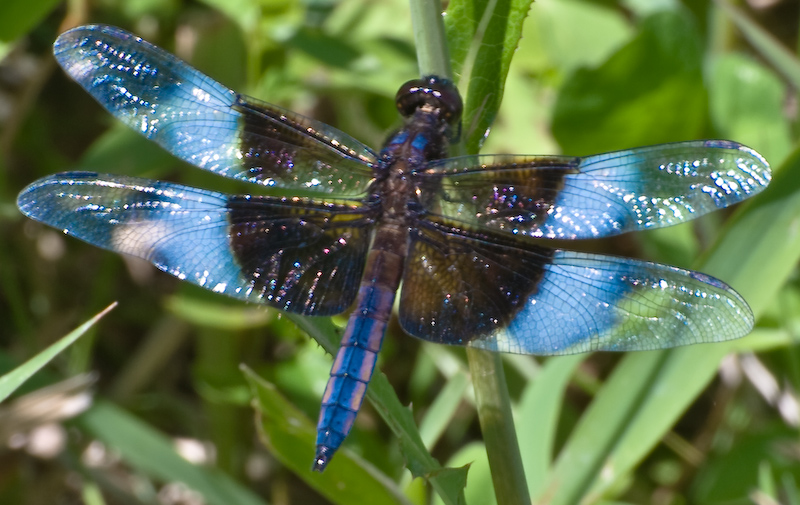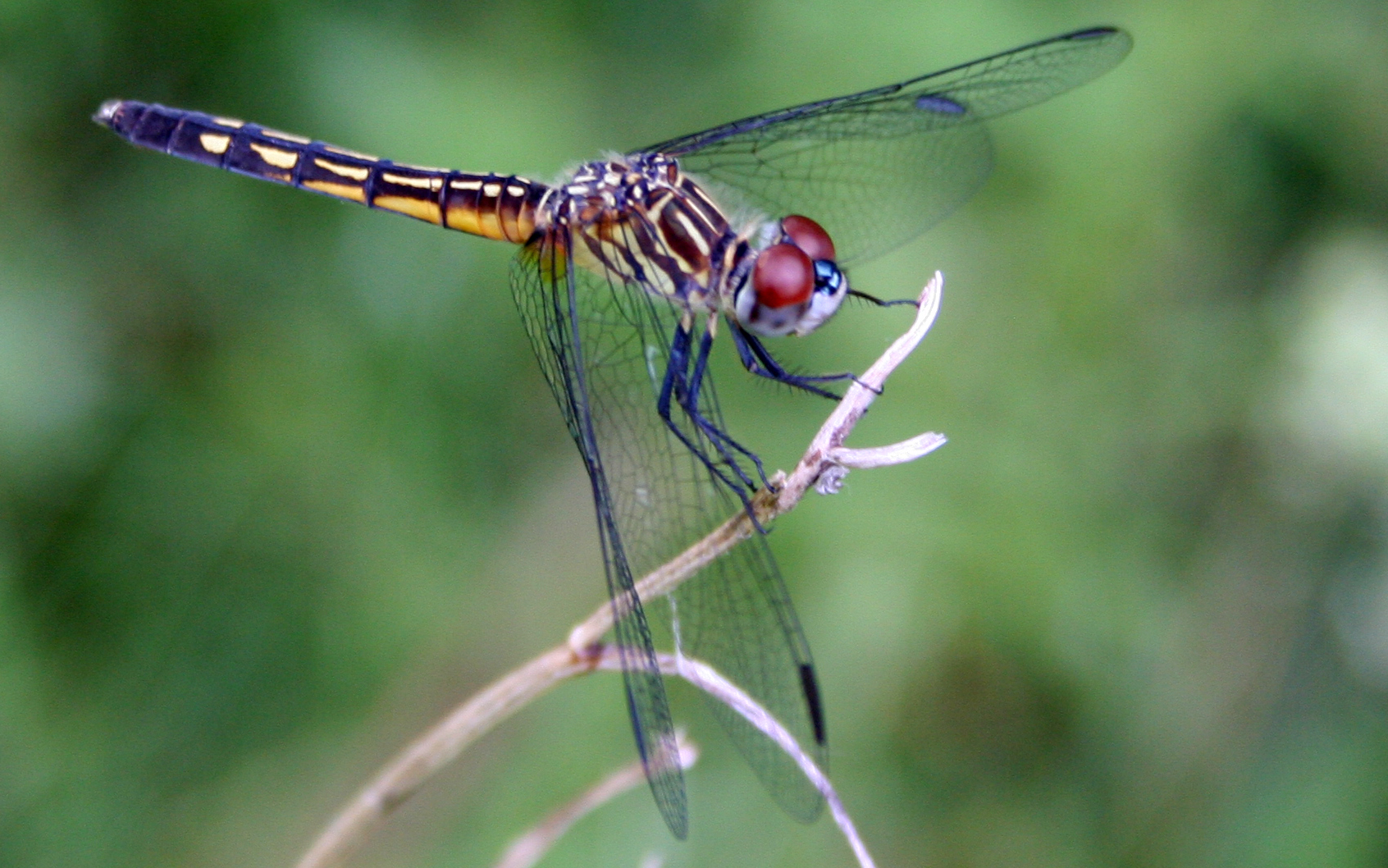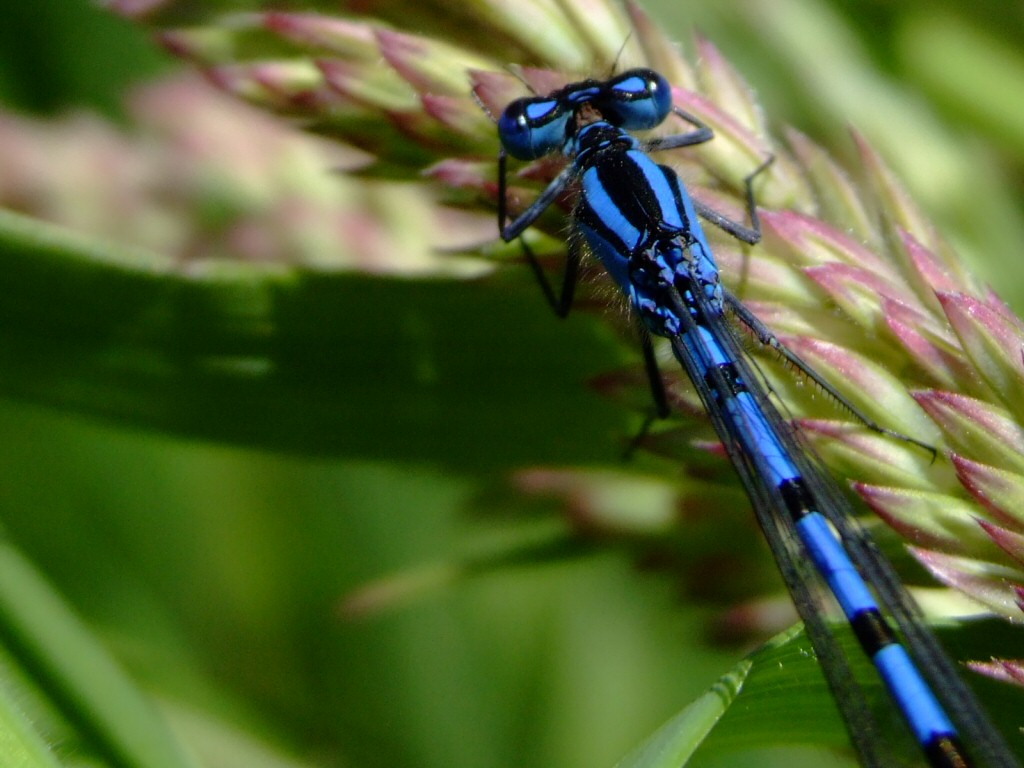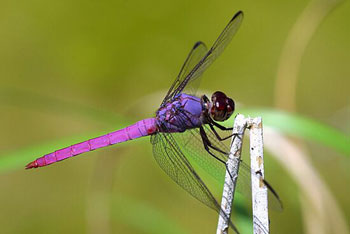A
dragonfly is an
insect belonging to the order
Odonata, the suborder
Epiprocta or, in the strict sense, the infraorder
Anisoptera (from
Greek ανισος
anisos, "uneven" + πτερος
pteros, "wings", because the
hindwing is broader than the
forewing).
[1] It is characterized by large
multifaceted eyes, two pairs of strong transparent
wings, and an elongated body. Dragonflies can sometimes be mistaken for
damselflies, which are
morphologically
similar; however, adults can be differentiated by the fact that the
wings of most dragonflies are held away from, and perpendicular to, the
body when at rest. Dragonflies possess six legs (like any other insect),
but most of them cannot walk well. Dragonflies are among the fastest
flying insects in the world.
Dragonflies are important
predators that eat
mosquitoes, and other small insects like
flies,
bees,
ants,
wasps, and very rarely
butterflies. They are usually found around marshes, lakes, ponds, streams, and
wetlands because their
larvae, known as "
nymphs", are aquatic. Some 5680 different species of dragonflies (Odonata) are known in the world today.
[2]
Though dragonflies are predators, they themselves are subject to
predation by birds, lizards, frogs, spiders, fish, water bugs, and even
other large dragonflies.
Classification
Formerly, the Anisoptera were given suborder rank beside the "ancient
dragonflies" (Anisozygoptera), which were believed to contain the two
living species of the genus
Epiophlebia and numerous fossil ones. More recently it turned out that the "Anisozygopterans" form a
paraphyletic assemblage of
morphologically primitive relatives of the Anisoptera. Thus, the Anisoptera (true dragonflies) are reduced to an
infraorder
in the new suborder Epiprocta (dragonflies in general). The artificial
grouping Anisozygoptera is disbanded, its members recognized as extinct
offshoots at various stages of dragonfly
evolution. The two living species formerly placed there—the Asian relict dragonflies—form the infraorder
Epiophlebioptera alongside Anisoptera.
Life cycle

Dragonfly emerging as an adult
Female dragonflies lay
eggs
in or near water, often on floating or emergent plants. When laying
eggs, some species will submerge themselves completely in order to lay
their eggs on a good surface. The eggs then hatch into
naiads. Most of a dragonfly's life is spent in the naiad form, beneath the water's surface, using
extendable jaws to catch other
invertebrates (often mosquito larvae) or even
vertebrates such as tadpoles and fish.
[3] They breathe through gills in their
rectum, and can rapidly propel themselves by suddenly expelling water through the anus.
[4] Some naiads even hunt on land,
[5] an aptitude that could easily have been more common in ancient times when terrestrial predators were clumsier.
The larval stage of large dragonflies may last as long as five years.
In smaller species, this stage may last between two months and three
years. When the naiad is ready to metamorphose into an adult, it climbs
up a
reed
or other emergent plant. Exposure to air causes the naiad to begin
breathing. The skin splits at a weak spot behind the head and the adult
dragonfly crawls out of its larval skin, pumps up its wings, and flies
off to feed on midges and flies. In flight the adult dragonfly can
propel itself in six directions; upward, downward, forward, back, and
side to side.
[6] The adult stage of larger species of dragonfly can last as long as five or six months.
Flight speed
Tillyard claimed to have recorded the
Southern Giant Darner flying at nearly 60 miles per hour (97 km/h) in a rough field measurement.
[7] However, the greatest reliable flight speed records are for other types of insects.
[8]
In general, large dragonflies like the hawkers have a maximum speed of
10–15 metres per second (22–34 mph) with average cruising speed of about
4.5 metres per second (10 mph).
[9]
Dragonflies and damselflies
Damselflies
(suborder Zygoptera), typically smaller than dragonflies, are sometimes
confused with newly moulted dragonflies. However, once a dragonfly
moults, it is already fully grown. There are other distinctions that set
them apart: most damselflies hold their wings at rest together above
the torso or held slightly open above (such as in the family Lestidae),
whereas most dragonflies at rest hold their wings perpendicular to their
body, horizontally or occasionally slightly down and forward. Also, the
back wing of the dragonfly broadens near the base, caudal to the
connecting point at the body, while the back wing of the damselfly is
similar to the front wing. The eyes on a damselfly are apart; in most
dragonflies the eyes touch. Notable exceptions are the
Petaluridae (Petaltails) and the
Gomphidae (Clubtails).
The largest living odonate by
wingspan is a damselfly from South America,
Megaloprepus caerulatus (Drury, 1782) while the second largest are females of the dragonfly
Tetracanthagyna plagiata (Wilson, 2009). The female
T. plagiata is probably the heaviest living odonate.
[10]
Common species
Northern hemisphere
- Twelve Spot Skimmer, "Libellula pulchella"
- Emperor, Anax imperator
- Keeled Skimmer, Orthetrum coerulescens
- Black-tailed Skimmer, Orthetrum cancellatum
- Common Whitetail, Libellula lydia
- Migrant Hawker, Aeshna mixta
- Azure Hawker, Aeshna caerulea
- Southern Hawker, Aeshna cyanea
- Norfolk Hawker, Aeshna isosceles
- Common Hawker, Aeshna juncea
- Red-veined Darter, Sympetrum fonscolombii
- Common Darter, Sympetrum striolatum
- Vagrant Darter, Sympetrum vulgatum
|
- Yellow-winged Darter, Sympetrum flaveolum
- Broad-bodied Chaser, Libellula depressa
- Four-spotted Chaser, Libellula quadrimaculata
- Scarce Chaser, Libellula fulva
- Green Darner, Anax junius
- Downy Emerald, Cordulia aenea
- Blue-eyed Darner, Aeshna multicolor
- Roseate Skimmer, Orthemis ferruginea
- Flame Skimmer, Libellula saturata
- Widow Skimmer, Libellula luctuosa
- Great Pondhawk, Erythemis vesiculosa
- Comet Darner, Anax longipes
- Banded Pennant, Celithemis fasciata
- Texas Emerald, Somatochlora margarita
|
Southern hemisphere
Gallery
Dragonflies in culture
In Europe, dragonflies have often been seen as sinister. Some English vernacular names, such as "
devil's darning needle" and "ear cutter", link them with evil or injury.
[11] A
Romanian folk tale says that the dragonfly was once a
horse possessed by the devil.
[citation needed] Swedish folklore holds that the devil uses dragonflies to weigh people's souls.
[12]:25–27 The
Norwegian name for dragonflies is
Øyenstikker ("eye-poker"), and in
Portugal they are sometimes called
tira-olhos ("eye-snatcher"). They are often associated with
snakes, as in the
Welsh name
gwas-y-neidr, "
adder's servant".
[11] The
Southern United States
term "snake doctor" refers to a folk belief that dragonflies follow
snakes around and stitch them back together if they are injured.
[13]

Dragonfly symbol on a
Hopi bowl from
Sikyatki archaeological site
For some Native American tribes they represent swiftness and activity, and for the
Navajo they symbolize pure water. Dragonflies are a common motif in
Zuni pottery; stylized as a double-barred cross, they appear in
Hopi rock art and on
Pueblo necklaces.
[12]:20–26
They have also been used in traditional medicine in Japan and China.
In some parts of the world they are a food source, eaten either as
adults or larvae; in
Indonesia, for example, they are caught on poles made sticky with
birdlime, then fried in oil as a
delicacy.
[11]
In the United States dragonflies and
damselflies are sought out as a hobby similar to birding and butterflying, known as oding, from the Latin name of the dragonfly order,
Odonata.
Oding is especially popular in Texas, where 225 different species of
odonates have been observed. With care, and with dry fingers,
dragonflies can be handled and released by oders, as can be done with
butterflies, though it is not encouraged.
[14]
Images of dragonflies are common in
Art Nouveau, especially in jewelry designs.
[15] They also appear in posters by modern artists such as
Maeve Harris.
[16] They have also been used as a decorative motif on fabrics and home furnishings.
[17] Douglas, a British motorcycle manufacturer based in Bristol, named its innovatively designed postwar 350cc flat twin model the
Dragonfly.
Japan
As a seasonal symbol in
Japan, the dragonfly is associated with
summer and early autumn.
[18]
More generally, dragonflies are symbols of courage, strength, and
happiness, and they often appear in art and literature, especially
haiku.
The love for dragonflies is reflected by traditional (layman's) names
for almost all of the 200 species of dragonflies found in and around
Japan.
[19]
Japanese children catch large dragonflies as a game, using a hair with a
small pebble tied to each end, which they throw into the air. The
dragonfly mistakes the pebbles for prey, gets tangled in the hair, and
is dragged to the ground by the weight.
[12]:38
Beyond this, one of Japan's historical names –
Akitsushima (
Kanji:
秋津島 Hiragana: あきつしま) – is an
archaic form meaning "Dragonfly Islands".
[20] This is attributed to a legend in which Japan's mythical founder,
Emperor Jinmu, was bitten by a
mosquito, which was then promptly eaten by a dragonfly.
[21][22]
See also





